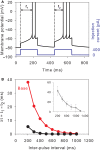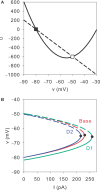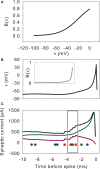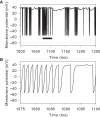Capturing dopaminergic modulation and bimodal membrane behaviour of striatal medium spiny neurons in accurate, reduced models
- PMID: 20011223
- PMCID: PMC2791037
- DOI: 10.3389/neuro.10.026.2009
Capturing dopaminergic modulation and bimodal membrane behaviour of striatal medium spiny neurons in accurate, reduced models
Abstract
Loss of dopamine from the striatum can cause both profound motor deficits, as in Parkinson's disease, and disrupt learning. Yet the effect of dopamine on striatal neurons remains a complex and controversial topic, and is in need of a comprehensive framework. We extend a reduced model of the striatal medium spiny neuron (MSN) to account for dopaminergic modulation of its intrinsic ion channels and synaptic inputs. We tune our D1 and D2 receptor MSN models using data from a recent large-scale compartmental model. The new models capture the input-output relationships for both current injection and spiking input with remarkable accuracy, despite the order of magnitude decrease in system size. They also capture the paired pulse facilitation shown by MSNs. Our dopamine models predict that synaptic effects dominate intrinsic effects for all levels of D1 and D2 receptor activation. We analytically derive a full set of equilibrium points and their stability for the original and dopamine modulated forms of the MSN model. We find that the stability types are not changed by dopamine activation, and our models predict that the MSN is never bistable. Nonetheless, the MSN models can produce a spontaneously bimodal membrane potential similar to that recently observed in vitro following application of NMDA agonists. We demonstrate that this bimodality is created by modelling the agonist effects as slow, irregular and massive jumps in NMDA conductance and, rather than a form of bistability, is due to the voltage-dependent blockade of NMDA receptors. Our models also predict a more pronounced membrane potential bimodality following D1 receptor activation. This work thus establishes reduced yet accurate dopamine-modulated models of MSNs, suitable for use in large-scale models of the striatum. More importantly, these provide a tractable framework for further study of dopamine's effects on computation by individual neurons.
Keywords: bimodality; bistability; phase plane analysis; signal-to-noise ratio; striatum.
Conflict of interest statement
The authors declare that the research was conducted in the absence of any commercial or financial relationships that could be construed as a potential conflict of interest.
Figures








Similar articles
-
Dopaminergic treatment weakens medium spiny neuron collateral inhibition in the parkinsonian striatum.J Neurophysiol. 2017 Mar 1;117(3):987-999. doi: 10.1152/jn.00683.2016. Epub 2016 Dec 7. J Neurophysiol. 2017. PMID: 27927785 Free PMC article.
-
Synchronized firing of fast-spiking interneurons is critical to maintain balanced firing between direct and indirect pathway neurons of the striatum.J Neurophysiol. 2014 Feb;111(4):836-48. doi: 10.1152/jn.00382.2013. Epub 2013 Dec 4. J Neurophysiol. 2014. PMID: 24304860 Free PMC article.
-
Effects of dopaminergic modulation on the integrative properties of the ventral striatal medium spiny neuron.J Neurophysiol. 2007 Dec;98(6):3731-48. doi: 10.1152/jn.00335.2007. Epub 2007 Oct 3. J Neurophysiol. 2007. PMID: 17913980
-
Differential striatal spine pathology in Parkinson's disease and cocaine addiction: a key role of dopamine?Neuroscience. 2013 Oct 22;251:2-20. doi: 10.1016/j.neuroscience.2013.07.011. Epub 2013 Jul 16. Neuroscience. 2013. PMID: 23867772 Free PMC article. Review.
-
D1 and D2 dopamine-receptor modulation of striatal glutamatergic signaling in striatal medium spiny neurons.Trends Neurosci. 2007 May;30(5):228-35. doi: 10.1016/j.tins.2007.03.008. Epub 2007 Apr 3. Trends Neurosci. 2007. PMID: 17408758 Review.
Cited by
-
Extreme value statistics of nerve transmission delay.PLoS One. 2024 Jul 5;19(7):e0306605. doi: 10.1371/journal.pone.0306605. eCollection 2024. PLoS One. 2024. PMID: 38968286 Free PMC article.
-
From model specification to simulation of biologically constrained networks of spiking neurons.Neuroinformatics. 2014 Apr;12(2):307-23. doi: 10.1007/s12021-013-9208-z. Neuroinformatics. 2014. PMID: 24253973 Free PMC article.
-
Basal ganglia role in learning rewarded actions and executing previously learned choices: Healthy and diseased states.PLoS One. 2020 Feb 10;15(2):e0228081. doi: 10.1371/journal.pone.0228081. eCollection 2020. PLoS One. 2020. PMID: 32040519 Free PMC article.
-
Dopaminergic Control of the Exploration-Exploitation Trade-Off via the Basal Ganglia.Front Neurosci. 2012 Feb 6;6:9. doi: 10.3389/fnins.2012.00009. eCollection 2012. Front Neurosci. 2012. PMID: 22347155 Free PMC article.
-
Striatal disorders dissociate mechanisms of enhanced and impaired response selection - Evidence from cognitive neurophysiology and computational modelling.Neuroimage Clin. 2014 Apr 12;4:623-34. doi: 10.1016/j.nicl.2014.04.003. eCollection 2014. Neuroimage Clin. 2014. PMID: 24936413 Free PMC article.
References
-
- Bolam J. P., Bergman H., Graybiel A. M., Kimura M., Plenz D., Seung H. S., Surmeier D. J., Wickens J. R. (2006). Microcircuits in the striatum. In Microcircuits: The Interface Between Neurons and Global Brain Function, Grillner S., Graybiel A. M., eds (Cambridge, MA, MIT Press; ), pp. 165–190.
LinkOut - more resources
Full Text Sources
Molecular Biology Databases
Research Materials
Miscellaneous

